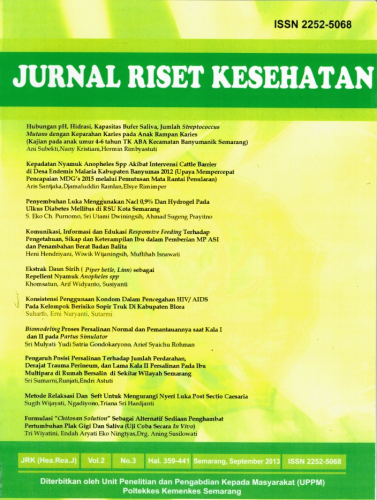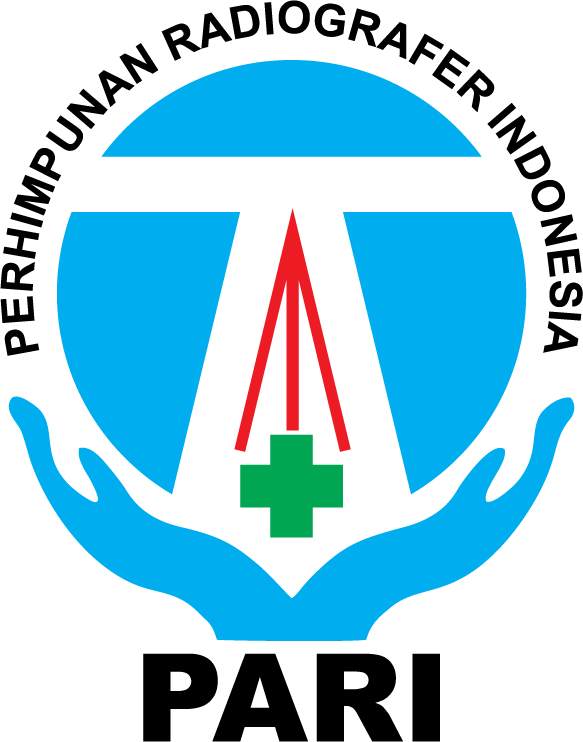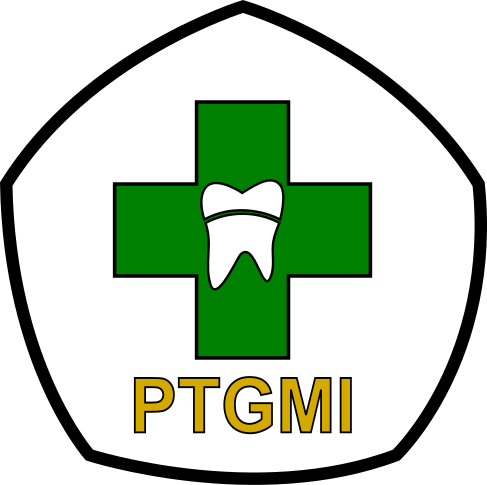Averrhoa bilimbi (Belimbing Wuluh) Leaves Extract Evaluation as Anti-Cariogenic Mouthwash
Abstract
Keywords
Full Text:
PDFReferences
Abdel-Raouf, N., Al-Enazi, N. M., Al-Homaidan, A. A., Ibraheem, I. B. M., Al-Othman, M. R., & Hatamleh, A. A. (2015). Antibacterial β-amyrin isolated from Laurencia microcladia. Arabian Journal of Chemistry, 8(1), 32–37. https://doi.org/10.1016/j.arabjc.2013.09.033
Ardini, D., & Mulatasih, R. (2020). Streptococcus Mutans Antibacterial Study: Mouthwash Preparations Formulation Using Cinnamon and Betel Leaf Essential Oils (Cinnamomum burmannii) (Piper betle L). International Journal of Innovation, Creativity and Change, Special Edition (Safe Communities). www.ijicc.net
Auw, L., Subehan, Sukrasno, Kadota, S., & Tezuka, Y. (2015). Constituents of Indonesian Medicinal Plant Averrhoa bilimbi and Their Cytochrome P450 3A4 and 2D6 Inhibitory Activities. Natural Product Communications, 10(1), 57–62.
Banavar Ravi, S., Nirupad, S., Chippagiri, P., & Pandurangappa, R. (2017). Antibacterial Effects of Natural Herbal Extracts on Streptococcus mutans: Can They Be Potential Additives in Dentifrices? International Journal of Dentistry, 2017 (Article ID 4921614). https://doi.org/10.1155/2017/4921614
Basir, N., Farid, N., Sadsyam, S., Utari, A. U., & Rahayu, A. B. U. (2023). Development and Physical Stability Test of Salak Fruit Peel Extract Mouthwash as a Plaque Preventative. Journal of Health Sciences and Medical Development, 2(02), 43–53. https://doi.org/10.56741/hesmed.v2i02.262
Chismirina, S., Andayani, R., & Sungkar, S. (2020). The Antibacterial Effects of Syzygium cumini Fruit Mouthwash Against Streptococcus mutans as an Agent of Dental Caries. Proceeding Book of the 3rd International Conference on Multidisciplinary Research, 03(1), 31–37.
Ferraz-Filha, Z. S., Michel Araújo, M. C. de P., Ferrari, F. C., Dutra, I. P. A. R., & Saúde-Guimarães, D. A. (2016). Tabebuia roseoalba: In Vivo Hypouricemic and Anti-inflammatory Effects of Its Ethanolic Extract and Constituents. Planta Medica, 82(16), 1395–1402. https://doi.org/10.1055/s-0042-105878
Gunawan, Cordero, A., & Paano, A. (2013, March). Structure elucidation of two new phytol derivatives, a new phenolic compound and other metabolites of Averrhoa bilimbi. Research Congress 2013 De La Salle University Manila.
Ifmaily, & Fitriani, P. R. (2020). The Antibacterial Mouthwash of Tapak Liman Leaves Extract (Elephanthopus scaber L) Against Streptococcus mutans. Jurnal Medika Hutama, 01(02), 86–91. http://jurnalmedikahutama.com
Imran, H., Kurniawati, N., Amiruddin, A., Nurdin, N., Wirza, W., & Wilis, R. (2022). The Effectiveness of Vegetable Starfruit Juice (Averrhoa bilimbi) and Rosella Tea (Hibiscus sabdariffa L) Against the Inhibition of Dental Plaque Formation. Open Access Macedonian Journal of Medical Sciences, 10(G), 599–602. https://doi.org/10.3889/oamjms.2022.8787
Ismail, S., Marliana, E., & Kosala, K. (2019). Effect of pH increasing of Wuluh star fruit (Averrhoa bilimbi L.) juice on vasodilatation activity. Journal of Physics: Conference Series, 1277(1). https://doi.org/10.1088/1742-6596/1277/1/012017
Lakmal, K., Yasawardene, P., Jayarajah, U., & Seneviratne, S. L. (2021). Nutritional and medicinal properties of Star fruit (Averrhoa carambola): A review. Food Science and Nutrition, 9(3), 1810–1823. https://doi.org/10.1002/fsn3.2135
Leliqia, N. P. E., & Safitri, I. (2021). A review of phytochemical properties, antibacterial activity, and toxicity study of Averrhoa bilimbi leaves and fruit. Journal of Pharmaceutical Science and Application, 3(1), 32–39. https://doi.org/10.24843/jpsa.2021.v03.i01.p04
Macfarlane, T. V., Kawecki, M. M., Cunningham, C., Bovaird, I., Morgan, R., Rhodes, K., & Watkins, R. (2010). Mouthwash Use in General Population: Results from Adult Dental Health Survey in Grampian, Scotland. Journal of Oral and Maxillofacial Research, 1(4), e2. https://doi.org/10.5037/jomr.2010.1301
Nurmalasari, D. L., Damiyanti, M., & Eriwati, Y. K. (2018). Effect of cinnamon extract solution on human tooth enamel surface roughness. IOP Conf. Series: Journal of Physics: Conf. Series 1073, 1073(3). https://doi.org/10.1088/1742-6596/1073/3/032022
Ponce, A. G., Fritz, R., Del Valle, C., & Roura, S. I. (2003). Antimicrobial Activity of Essential Oils on The Native Microflora of Organic Swiss Chard. LWT - Food Science and Technology, 36(7), 679–684. https://doi.org/10.1016/S0023-6438(03)00088-4
Radzki, D., Wilhelm-Węglarz, M., Pruska, K., Kusiak, A., & Ordyniec-Kwaśnica, I. (2022). A Fresh Look at Mouthwashes—What Is Inside and What Is It for? International Journal of Environmental Research and Public Health, 19(7). https://doi.org/10.3390/ijerph19073926
Rahimulinsan, R., Faridah, A., Yulastri, A., & Holinesti, R. (2018). Using Belimbing Wuluh (Averhoa blimbi L.) as a Functional Food Processing Product. Proceedings of the 1st International Conference on Culinary, Fashion, Beauty, and Tourism, 177–187. http://bibitbunga.com
Rahman, S., & Ariastuti, R. (2021). Formulation of Mouthwash Preparations Ethanol Extract of Coffee Beans Roasted Robusta (Coffea canephora) and Effectiveness Test on Bacteria Streptococcus mutans. Journal of Nutraceuticals and Herbal Medicine |, 4(1), 53–65. http://journals.ums.ac.id/index.php/jnhm
Rajendiran, M., Trivedi, H. M., Chen, D., Gajendrareddy, P., & Chen, L. (2021). Recent Development of Active Ingredients in Mouthwashes and Toothpastes for Periodontal Diseases. Molecules, 26(2001). https://doi.org/10.3390/molecules
Renuka, S., & Muralidharan, N. P. (2017). Comparison in benefits of herbal mouthwashes with chlorhexidine mouthwash: A review. Asian Journal of Pharmaceutical and Clinical Research, 10(2), 3–7. https://doi.org/10.22159/ajpcr.2017.v10i2.13304
Rozi, F., Silvy, D., & Syukri, D. (2022). Characterization of Herbal Tea Bags Made from Starfruit Leaves (Averrhoa bilimbi), Gotu Kola Leaves (Centella asiatica) and Cinnamon Powder (Cinnamomun burmanii) as Functioal drinks. Andalasian International Journal of Agriculture and Natural Sciences (AIJANS), 3(01), 47–54. https://doi.org/10.25077/aijans.v3.i01.47-54.2022
Saputera, D., Zufira, I., & Yulia Budiarti, L. (2018). Inhibition Activity of Belimbing Wuluh (Averrhoa bilimbi Linn) Leaf Extract to Streptococcus mutans on Acrylic Plate. Dentino (Jur. Ked. Gigi), III(1), 10–14.
Sharma, A., Agarwal, N., Anand, A., & Jabin, Z. (2018). To compare the effectiveness of different mouthrinses on Streptococcus mutans count in caries active children. Journal of Oral Biology and Craniofacial Research, 8(2), 113–117. https://doi.org/10.1016/j.jobcr.2018.05.002
Sulasmi, E. S., Indriwati, S. E., & Suarsini, E. (2016). Preparation of Various Type of Medicinal Plants Simplicia as Material of Jamu Herbal. International Conference on Education, Education in the 21th Century: Responding to Current Issues, 1014–1024.
Tadin, A., Guberina, R. P., Domazet, J., & Gavic, L. (2022). Oral Hygiene Practices and Oral Health Knowledge among Students in Split, Croatia. Healthcare (Switzerland), 10(2). https://doi.org/10.3390/healthcare10020406
Ustrell-Borràs, M., Traboulsi-Garet, B., & Gay-Escoda, C. (2020). Alcohol-based mouthwash as a risk factor of oral cancer: A systematic review. Med Oral Patol Oral Cir Bucal, 25(1), e1–e12. https://doi.org/10.4317/medoral.23085
Utamaningyas, A., Pramesti, H., & Balafif, F. (2022). The Streptococcus mutans ability to survive in biofilms and during dental caries formation: scoping review. JDS, 7(2), 150–158.
Wang, S., Yao, J., Zhou, B., Yang, J., Chaudry, M. T., Wang, M., Xiao, F., Li, Y., & Yin, W. (2018). Bacteriostatic Effect of Quercetin as An Antibiotic Alternative In Vivo and Its Antibacterial Mechanism In Vitro. Journal of Food Protection, 81(1), 67–78. https://doi.org/10.4315/0362-028X.JFP-17-214
Werner, C. W. D. A., & Seymour, R. A. (2009). Are alcohol containing mouthwashes safe? British Dental Journal, 207(E19). https://doi.org/10.1038/sj.bdj.2009.1014
Widhianto, E. K., Elmarda, R. V., & Rakhmawatie, M. D. (2017). Effectivity in vitro of Averrhoa bilimbi L ethanolic extract againts Escherichia coli and Staphylococcus aureus growth. Prosiding Seminar Nasional Pendidikan, Sains Dan Teknologi, 140–148. https://jurnal.unimus.ac.id/index.php/psn12012010/article/viewFile/2822/2734
Yelfi, Y., Susilo, H., & Kurnia, N. M. (2022). Mouthwash of Amaranthus hybridus L. left extract with ethyl acetate as a Streptococcus mutans antibacterial. Jurnal Ilmiah Farmasi Farmasyifa, 5(1), 79–90. https://doi.org/10.29313/jiff.v5i1.8379
Yousefimanesh, H., Amin, M., Robati, M., Goodarzi, H., & Otoufi, M. (2015). Comparison of the Antibacterial Properties of Three Mouthwashes Containing Chlorhexidine Against Oral Microbial Plaques: An in vitro Study. Jundishapur Journal of Microbiology, 8(2). https://doi.org/10.5812/jjm.17341
Yuvanatemiya, V., Srean, P., Klangbud, W. K., Venkatachalam, K., Wongsa, J., Parametthanuwat, T., & Charoenphun, N. (2022). A Review of the Influence of Various Extraction Techniques and the Biological Effects of the Xanthones from Mangosteen (Garcinia mangostana L.) Pericarps. Molecules. 27(8775) (https://doi.org/10.3390/molecules27248775
Zhang, Q. W., Lin, L. G., & Ye, W. C. (2018). Techniques for extraction and isolation of natural products: A comprehensive review. Chinese Medicine (United Kingdom), 13(1). https://doi.org/10.1186/s13020-018-0177-x
DOI: https://doi.org/10.31983/jrk.v13i1.10750
Article Metrics
Refbacks
- There are currently no refbacks.
Copyright (c) 2024 Jurnal Riset Kesehatan




















































